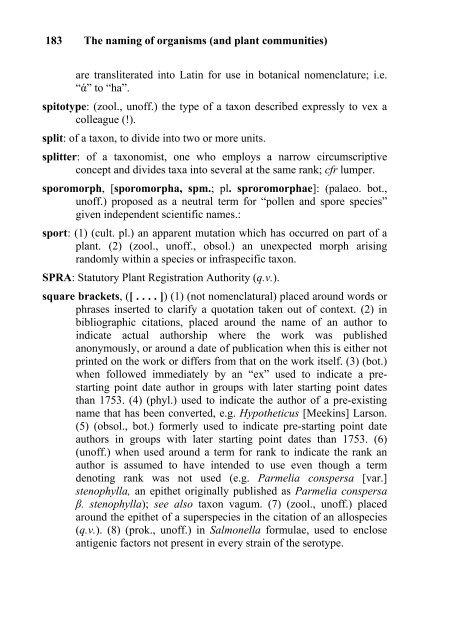Access Resource - Global Biodiversity Information Facility
Access Resource - Global Biodiversity Information Facility
Access Resource - Global Biodiversity Information Facility
Create successful ePaper yourself
Turn your PDF publications into a flip-book with our unique Google optimized e-Paper software.
183 The naming of organisms (and plant communities)<br />
are transliterated into Latin for use in botanical nomenclature; i.e.<br />
“ά” to “ha”.<br />
spitotype: (zool., unoff.) the type of a taxon described expressly to vex a<br />
colleague (!).<br />
split: of a taxon, to divide into two or more units.<br />
splitter: of a taxonomist, one who employs a narrow circumscriptive<br />
concept and divides taxa into several at the same rank; cfr lumper.<br />
sporomorph, [sporomorpha, spm.; pl. sproromorphae]: (palaeo. bot.,<br />
unoff.) proposed as a neutral term for “pollen and spore species”<br />
given independent scientific names.:<br />
sport: (1) (cult. pl.) an apparent mutation which has occurred on part of a<br />
plant. (2) (zool., unoff., obsol.) an unexpected morph arising<br />
randomly within a species or infraspecific taxon.<br />
SPRA: Statutory Plant Registration Authority (q.v.).<br />
square brackets, ([ . . . . ]) (1) (not nomenclatural) placed around words or<br />
phrases inserted to clarify a quotation taken out of context. (2) in<br />
bibliographic citations, placed around the name of an author to<br />
indicate actual authorship where the work was published<br />
anonymously, or around a date of publication when this is either not<br />
printed on the work or differs from that on the work itself. (3) (bot.)<br />
when followed immediately by an “ex” used to indicate a prestarting<br />
point date author in groups with later starting point dates<br />
than 1753. (4) (phyl.) used to indicate the author of a pre-existing<br />
name that has been converted, e.g. Hypotheticus [Meekins] Larson.<br />
(5) (obsol., bot.) formerly used to indicate pre-starting point date<br />
authors in groups with later starting point dates than 1753. (6)<br />
(unoff.) when used around a term for rank to indicate the rank an<br />
author is assumed to have intended to use even though a term<br />
denoting rank was not used (e.g. Parmelia conspersa [var.]<br />
stenophylla, an epithet originally published as Parmelia conspersa<br />
β. stenophylla); see also taxon vagum. (7) (zool., unoff.) placed<br />
around the epithet of a superspecies in the citation of an allospecies<br />
(q.v.). (8) (prok., unoff.) in Salmonella formulae, used to enclose<br />
antigenic factors not present in every strain of the serotype.









